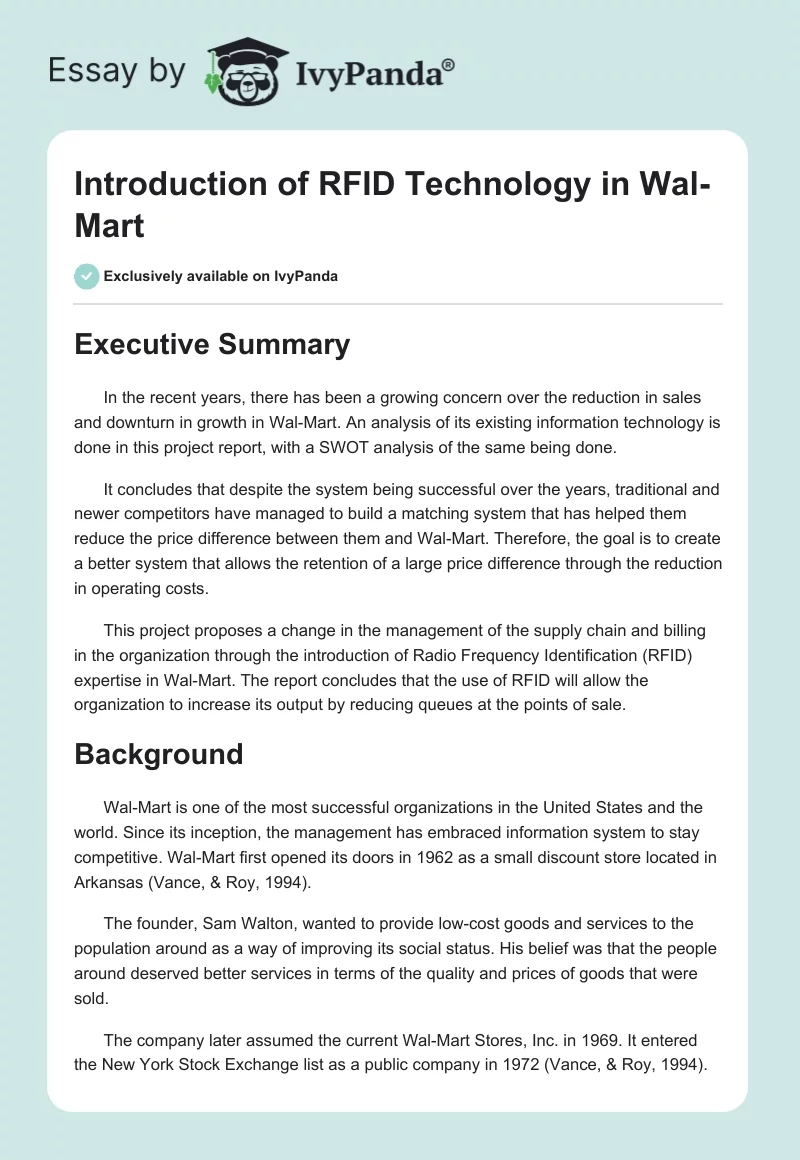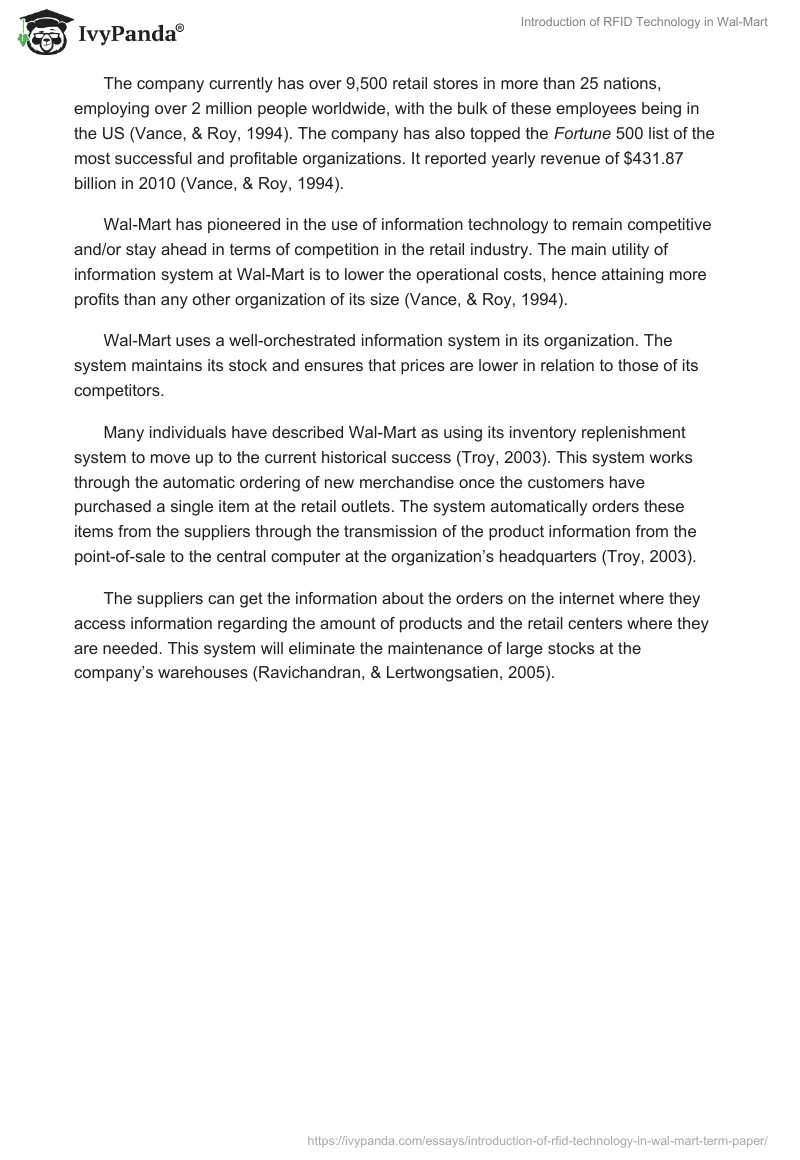Executive Summary
In the recent years, there has been a growing concern over the reduction in sales and downturn in growth in Wal-Mart. An analysis of its existing information technology is done in this project report, with a SWOT analysis of the same being done.
It concludes that despite the system being successful over the years, traditional and newer competitors have managed to build a matching system that has helped them reduce the price difference between them and Wal-Mart. Therefore, the goal is to create a better system that allows the retention of a large price difference through the reduction in operating costs.
This project proposes a change in the management of the supply chain and billing in the organization through the introduction of Radio Frequency Identification (RFID) expertise in Wal-Mart. The report concludes that the use of RFID will allow the organization to increase its output by reducing queues at the points of sale.
Background
Wal-Mart is one of the most successful organizations in the United States and the world. Since its inception, the management has embraced information system to stay competitive. Wal-Mart first opened its doors in 1962 as a small discount store located in Arkansas (Vance, & Roy, 1994).
The founder, Sam Walton, wanted to provide low-cost goods and services to the population around as a way of improving its social status. His belief was that the people around deserved better services in terms of the quality and prices of goods that were sold.
The company later assumed the current Wal-Mart Stores, Inc. in 1969. It entered the New York Stock Exchange list as a public company in 1972 (Vance, & Roy, 1994).
The company currently has over 9,500 retail stores in more than 25 nations, employing over 2 million people worldwide, with the bulk of these employees being in the US (Vance, & Roy, 1994). The company has also topped the Fortune 500 list of the most successful and profitable organizations. It reported yearly revenue of $431.87 billion in 2010 (Vance, & Roy, 1994).
Wal-Mart has pioneered in the use of information technology to remain competitive and/or stay ahead in terms of competition in the retail industry. The main utility of information system at Wal-Mart is to lower the operational costs, hence attaining more profits than any other organization of its size (Vance, & Roy, 1994).
Wal-Mart uses a well-orchestrated information system in its organization. The system maintains its stock and ensures that prices are lower in relation to those of its competitors.
Many individuals have described Wal-Mart as using its inventory replenishment system to move up to the current historical success (Troy, 2003). This system works through the automatic ordering of new merchandise once the customers have purchased a single item at the retail outlets. The system automatically orders these items from the suppliers through the transmission of the product information from the point-of-sale to the central computer at the organization’s headquarters (Troy, 2003).
The suppliers can get the information about the orders on the internet where they access information regarding the amount of products and the retail centers where they are needed. This system will eliminate the maintenance of large stocks at the company’s warehouses (Ravichandran, & Lertwongsatien, 2005).
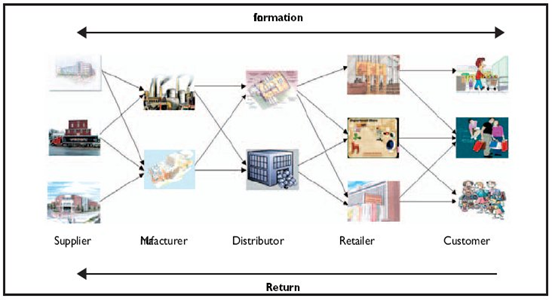
Figure: Supply chain such as used by Wal-Mart-Auto-ID: Managing Anything, Anywhere, Anytime in the Supply Chain, Bose and Pal, ACM
Source: (Bose, & Pal, 2005)
Another example of how Wal-Mart uses technology at its retail centers is the use of self-check-out, which allows customers to avoid the long queues at the points of sale (Vance, & Roy, 1994). The company has also established strong presence in the online shopping market. Through this e-commerce, customers can purchase their desired items on the internet (Ravichandran, & Lertwongsatien, 2005).
This service has allowed Wal-Mart to expand its services to the populations in some geographic areas that it does not cover (Troy, 2003). Although Wal-Mart is a good example of companies that utilize information technology to stay competitive, some challenges are still evident in its effective use of the technology.
Statement of Problem
Wal-Mart remains the single largest retail outlet company in the United States and in the world. However, the growth that the company has experienced and the policy of providing low prices of goods and service have worked against the company. The company has been made to put in place a series of measures to ensure that the competitive edge is retained over the other competitors (Troy, 2003).
In the last decade, the double-digit growth that Wal-Mart was previously experiencing began to decline, with this decline causing worries in the management and other stakeholders (Troy, 2003). The company was seen as experiencing problems mostly in its inventory management and cost control (Wang, 2006, p. 45).
Recent studies indicate that the price advantage that Wal-Mart held over its competitors and the perception that consumers had are diminishing (Wang, 2006). Consumers are increasingly seeing the organization as being as expensive as any other outlet, with recent studies also showing a narrowing down of the price differences between Wal-Mart and its competitors (Troy, 2003).
The observation of the price changes is worrying for the organization that has built its business based on this “low price” advantage for a number of years. The concept was the main offer that customers relied on from Wal-Mart.
Strategy Developed
A number of strategies have been analyzed and put in place at Wal-Mart to stem the negative growth that is likely to be observed over the next few years. The publicly traded company has the executives increasing the share purchases in the attempt of increasing the earnings in the share sale (Wang, 2006).
The other area of focus that the organization has majored in is the international market. Wal-Mart has made a number of acquisitions in the international market, with this move being aimed at buying revenue and increasing its total revenue as a result (Wang, 2006, p. 51).
The other measure that the company has undertaken to maintain the low-cost advantage over its competitors is the reduction of the workforce and initiation of measures to increase labor productivity (Quinn, 2000).
However, the measures have been criticized because of the effects that it has in reducing the number of experienced workers in the organization, the introduction of inventory problems that were not a traditional problem, and the loss of revenue. The company has lost revenue through the inadequacy of staff during peak hours at the registers due to few sales floor associates (Roberts, & Berg, 2012).
Therefore, Wal-Mart needs an efficient method of conducting business in the current financial dispensation to remain productive and/or retain the brand image that it has created over the years (Wallace, 2012). The problem can be solved through the efficient use of Radio Frequency Identification (RFID).
RFID is a newer form of technology that has the capability to allow the organization to carry out billing, supply chain management, and tracking of supplies with less human intervention as compared to barcodes (Bose, & Pal, 2005). A SWOT analysis will be important to assess the state of the information technology system at Wal-Mart stores.
SWOT Analysis
Strengths
The suggested information system at Wal-Mart exhibits a number of strengths The company’s image is the biggest beneficiary of the IT strategy. The system will facilitate its market as the company that provides the cheapest goods in their retail stores. The strategy has the strength of creating a cost advantage for Wal-Mart over its competitors in the industry (Laudon, & Laudon, 2010).
The system will also create an efficient distribution system for the organization, thus ensuring goods are replenished immediately. The brand image for the company, which is “We Sell for Less” will significantly be built of this information technology strategy.
Wal-Mart is will be able to utilize economies of scale in its supply chain, with the utility of the information system mainly being in the distribution of the inventory to the warehouses and retail outlets.
Weaknesses
However, a number of weaknesses in the current IT strategy are evident in the organization. The weaknesses are currently being observed in the latest problems that the organization is facing in its price difference with its major competitors (Roberts, & Berg, 2012). The company has experienced high turnover rates, with the annual rates being about 45% in the recent past (Laudon, & Laudon, 2010).
There has been a growing concern also that the organization that is present in a number of regions across the US has had a weaker presence in the major metropolitan areas as compared to some of her competitors. The stagnant technology use in the organization has also ensured that its competitors copy the technology, with some being more advanced than Wal-Mart in the use of technology in their operations.
The major weakness that the suggested IT system will have is the substantial amount of time is needed to have it introduced and used by the organization’s staff. Besides, the use of this technology would be a bit expensive to introduce at the organization, but this would only be in the initial stages of installation. The application will see the reduction in the operating costs for the organization, hence improvement in the overall performance.
Opportunities
The use of this technological system at Wal-Mart has several opportunities for the organization, especially the use of the internet. The system will allow Wal-Mart to expand to other geographic areas in the US and around the world.
There is also the opportunity of acquisition of smaller organizations in the industry, and especially those operating similar IT systems, with this being a growth indicator and reduction in competition (Quinn, 2000).
The alliance of Wal-Mart with IT companies is another opportunity that will see the expansion of its operations on the online stage (Fishman, 2006). These opportunities provide a stage for the expansion of the organization and a reversal of the decrease in growth observed in the last few years.
Threats
Wal-Mart and its IT strategy face a number of threats in the contemporary global economic age. One of the threats is the increased competition from a number of old and new competitors, with these organizations being able to apply the same technological advantages to catch up with Wal-Mart (Quinn, 2000).
Wal-Mart is likely to experience a number of setbacks in its application of technology, with one of these being the lawsuit such as the one that was filed in the federal court with the allegations that the organization was exhibiting discrimination against women in its operations (Roberts, & Berg, 2012).
The information age has also worked against the organization, with bad publicity being the result of the advances in the informational age in terms online of operations (Roberts, & Berg, 2012).
Goal of the Technology
The goal of the project is to create an effective IT system in Wal-Mart. According to Wallace (2012), the system is able to complement the existing IT infrastructure and enable the organization to save on the much-needed operational costs. The organization has developed a network that is based on the efficiency of its information system.
Hence, the problems that are currently being witnessed may be resulting from the failure of some components of this system. The suggested solution should be sufficient to enable improved data storage, distribution, and inventory replenishment as previously experienced in the organization (Wailgum, 2007).
The goal is to replace the billing system at Wal-Mart with a smarter way of billing, which must be efficient enough to allow effective logistics management. The billing system that is currently in place in Wal-Mart is partly effective, with its application being only in the supply chain. The use of the barcodes constitutes the main application of technology at the points of sale.
Despite the barcodes traditionally being used by the organization to manage the sales, the supply chain management is a crucial role that is not efficiently being undertaken in the organization (Wailgum, 2007). There is the need to substitute this technology with a more advanced and efficient one to capture a larger market and organizational capacity.
Solution
Due to the problems raised above in the information technology department in the organization in the use of barcodes in the management of sales, this project proposes the use of Radio Frequency Identification (RFID) at the points of sale in the retail outlets in the organization (Bose, & Pal, 2005). The wireless device that is associated with this technology can significantly reduce the workload in the organization.
It has a large capacity for data as compared to other similar billing and supply chain management methods (Bose, & Pal, 2005). The device is built on the concept of allowing identification of tagged objects. Unlike the use of barcodes, it does not require the objects to be in the line of sight (Bose, & Pal, 2005).

Fig: RFID Device-The Magic of RFID, Roy Want, Intel Research
Source: (Bose, & Pal, 2005)
The ability of the RFID to read and identify objects while they are not necessarily in the line of sight constitutes the single most important advantage of using the device over barcodes (Bose, & Pal, 2005). This means that at the point of sale, employees can increase their speed by scanning a number of items at the same time. Besides, items that are hidden can also be identified (Bose, & Pal, 2005).
In the management of the supply chain that is needed at the moment in Wal-Mart, the use of RFID can be utilized to make it more efficient.
The use of a serial number in the products has an added advantage in the supply chain since more information is available about the product in the supply chain as compared to that which would be carried by other non-specialized barcodes such as those used in European Article Numbering (EAN) and Universal Product Codes (UPC) (Bose, & Pal, 2005).
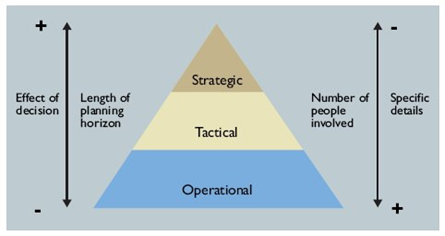
Fig: Three Levels of SCM Auto-ID: Managing Anything, Anywhere, Anytime in the Supply Chain
Source: (Bose, & Pal, 2005)
Apart from the use of FRID to monitor the sales in the organization, it can also complement other systems in place to monitor theft of the merchandise at the retail centers.
The system also enables easier classification of items and especially in the assessment of the freshness of perishable products, hence the use of first-in-first-out (FIFO) strategy (Bose, & Pal, 2005). The suppliers can also be given information on the retail conditions of the products they supply more efficiently.
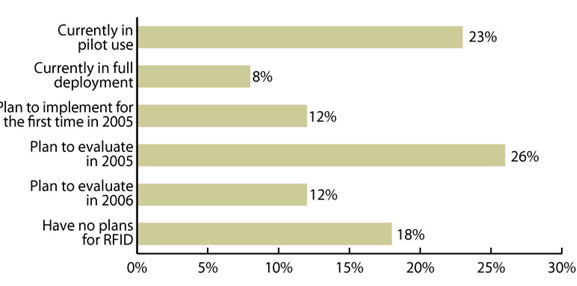
Figure: Future of SRFID ARM research, 2005
Source: (Bose, & Pal, 2005)
Conclusion
Since the introduction of a centralized supply chain and efficient technological supply chain management policies, Wal-Mart managed to lower the prices of the goods that are sold at its outlets.
This project has proposed a change in the management of the supply chain and billing in the organization through the introduction of RFID to increase output by reducing queues at the points of sale. The introduction of this technological innovation would also provide more information on the organization’s supply chain since more information would be stored in the gadgets.
Reference List
Bose, H., & Pal, D. (2005). Auto-ID: Managing Anything, Anywhere, Anytime in the Supply Chain. ACM Digital Library. Communications of the ACM, 48(8), 100-106.
Fishman, C. (2006). The Wal-Mart effect: how the world’s most powerful company really works– and how it’s transforming the American economy. New York, NY: Penguin Press.
Laudon, C., & Laudon, P. (2010). Managing information systems-managing the digital firm. Upper Saddle River, NJ: Pearson Prentice Hall.
Quinn, B. (2000). How Wal-Mart is Destroying America and the World. Berkeley CA: Ten Speed Press.
Ravichandran, T., & Lertwongsatien, C. (2005). Effect of Information Systems Resources and Capabilities on Firm Performance: A Resource-Based Perspective. Journal of Management Information Systems / Spring, 21(4), 237-276.
Roberts, R., & Berg, N. (2012). Wal-Mart: key insights and practical lessons from the world’s largest retailer. London: Kogan Page.
Troy, M. (2003). Logistics still cornerstone of competitive advantage-Wal-Mart The Category King: A new era of excellence. Business Library. Web.
Vance, S., & Roy, S. (1994). Wal-Mart. A History of Sam Walton’s Retail Phenomenon. New York, NY. Twayne Publishing.
Wailgum, T. (2007). 45 years of Wal-Mart history: a technology time line. Web.
Wallace, P. (2012). Information Systems in Organizations. London: Prentice Hall.
Wang, J. (2006). Economies of IT Systems at Wal-Mart: A Historical Perspective. Academy of Information and Management Sciences Journal, 9(1), 45-66.


 3.67
3.67